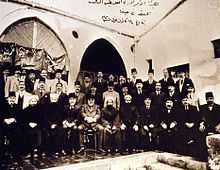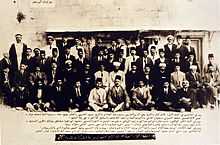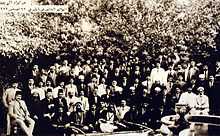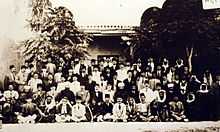Palestine Arab Congress
The Palestine Arab Congress was a series of congresses held by the Palestinian Arab population, organized by a nationwide network of local Muslim-Christian Associations, in the British Mandate of Palestine. Between 1919 and 1928, seven congresses were held in Jerusalem, Jaffa, Haifa and Nablus. Despite broad public support their executive committees were never officially recognised by the British, who claimed they were unrepresentative.[1] After the British defeat of Ottoman forces in 1918, the British established military rule and (later) civil administration of Palestine. The Palestine Arab Congress and its organizers in the Muslim-Christian Associations were formed when the country's Arab population began coordinated opposition to British policies.
First congress: Jerusalem, 1919
In response to Jewish immigrants settling before the war,[2] the first Palestine Arab Congress met from 27 January to 10 February 1919, with 27 delegates from Muslim-Christian societies across Palestine. It was presided over by Aref al-Dajani, president of the Jerusalem Muslim-Christian Society. Also present were Izzat Darwaza and Yusef al-'Isa, editor of Falastin. Most delegates were from the propertied class, and were evenly divided into pro-British and pan-Arab factions. A cable was sent to the Paris Peace Conference, demanding a renunciation of the Balfour Declaration and the inclusion of Palestine as "an integral part of...the independent Arab Government of Syria within an Arab Union, free of any foreign influence or protection".[3]
The Congress rejected political Zionism, agreeing to accept British assistance if it did not impinge on Arab sovereignty in Palestine. Palestine was envisaged as part of an independent Syrian state, governed by Faisal of the Hashemite family.[4]
The resolutions of the Jerusalem Congress were:
- Palestine should be part of Arab Syria
- Rejection of French proposals for the area
- No foreign influence
- All foreign treaties referring to the area were voided
- To maintain friendly relations with Britain and the Allied powers, accepting help if it did not affect the country's independence
It was decided to send a delegation to Damascus, and three members were chosen to attend the Peace Conference in Paris; however, the Paris delegation to Paris was forbidden from leaving the country. Failing to elect an executive committee, the congress agreed to meet in three months[5][6][7] and representatives attended the General Syrian Congress in Damascus on 8 June 1919.[8]
Second congress: 1920
The second congress was held in secret on 31 May 1920, because British military authorities had banned all Arab political gatherings. A statement was issued calling for the return of all political deportees, and protesting the San Remo Conference decision to include the words of the Balfour Declaration in the text of the British mandate over Palestine.[9] According to one source, the delegates met in Damascus on 27 February 1920.[10]
Third congress: Haifa, 1920

The third congress opened on 4 December. It was attended by 36 delegates, including Sheik Suleiman al-Taji Al-Faruqi and head of the Catholic community Bullus Shehadeh. The congress was opened by Haifa's mufti, Muhammad Murad. Recently deposed mayor of Jerusalem Musa al-Husayni was elected president and chairman of the nine-member executive committee, a post he held until his death in 1934. The congress called for Palestine to be ruled under identical terms as those of the Mandate of Iraq, with a parliament elected by a one-citizen-one-vote system.[11] Other resolutions:
- Called for Palestine to be part of the independent Arab state promised in the McMahon–Hussein Correspondence. Calls for unity with Syria were dropped, since the area was now under French control.
- Condemned the notion of a homeland for the Jewish people.
- Objected to the recognition of the World Zionist Organisation as an official body and the use of Hebrew as an official language.
- Opposed Jewish immigration.
- Declared the British administration illegal, since the League of Nations had not yet reached a decision about the status of the territory.
Some delegates, such as Daoud Isa, complained that the congress was not sufficiently radical. After the congress the executive committee met British High Commissioner Herbert Samuel, who insisted that they accept British policy on the Jewish national homeland to receive official recognition. The British claim that the congress was not representative led to a broad campaign by the Muslim-Christian Associations to raise public awareness.[12][13]
In March 1921 Musa Kazem led a delegation from the executive committee to meet the British Colonial Secretary Winston Churchill, who had called a conference in Cairo to decide British policy in the Middle East. Churchill agreed to meet the delegation, but refused to discuss any issues until after the conference. On his journey back to London he met with members of the executive committee in Jerusalem on 28 March 1921, telling them they had to accept the Balfour Declaration as an immutable part of British policy.[14]
Fourth congress: Jerusalem, 1921

The fourth congress, on 25 June 1921, was attended by about 100 delegates who voted to send a six-man delegation (led by Musa Kazim) to London. The delegates arrived in London in September and met with the Secretary of State for the Colonies, Winston Churchill. On their way, they met Pope Benedict XV in Vatican City and attempted to meet with delegates to the League of Nations in Geneva. Responsding to the congress, High Commissioner Herbert Samuel promised that the British would "never impose a policy contrary to their religions, their political and their economic interests".[15][16][17]
Fifth congress: Nablus, 1922

The fifth congress opened on 22 August 1922, after the return of the London delegation. Its leader, Musa Kazem, opposed anti-British agitation and discouraged the use of violence; he reported that possibilities still existed for progress through negotiations. The following resolutions were passed:
- Rejecting the new constitution.
- Boycotting elections for the proposed Legislative Council.
- Establishing a London bureau.
- Boycotting Jewish goods, including Pinhas Rutenberg's planned electricity supply.
- Forbidding land sales to Jews.
- Forbidding Jewish immigration.
- Pledging to oppose the establishment of a Jewish national homeland.
Before the congress, its executive committee launched a fundraising campaign supporting a general strike held on 13–14 July 1922. Funds were raised from sales of National Movement stamps selling for one, two and five millims. The stamps depicted the Dome of the Rock, with "Palestine for the Arabs" in English and Arabic.[20]
Sixth congress: Jaffa, 1923

Held from 16–20 June 1923, the congress was chaired by Musa Kazim. It was agreed to send another delegation to London, eschewing the more-radical policies which were advocated. A proposed campaign of non-payment of taxes, arguing no taxation without representation, was debated without a decision. Twenty-four resolutions were passed, including boycotts of Pinhas Rutenberg's Palestine Electricity Corporation and Jewish goods.[21] In October, the more-radical National Party was formed in opposition to the Muslim-Christian Associations and the executive committee.[22]
Seventh congress: Jerusalem, 1928
Held on 20 June 1928, the congress formed a short-lived united front with Musa Kazim as president.[23] A 48-member executive committee was elected, which selected an administrative staff consisting of a president, three secretaries and two other members. It was decided to send another delegation, the fourth, to London. It set out on 21 March 1930, after the publication of the Shaw Commission report on the 1929 riots.
General Islamic Congress: Jerusalem, 1931
As the influence of the Palestine Congress and its executive committee began to wane, other groups and leaders became active; in particular, the Supreme Muslim Council (and its president, Haj Amin al-Husseini) became involved in anti-Zionist activities. In 1931 Amin Husseini began organising an international conference of Muslim delegates, political and religious, Sunni and Shia, from around the world to be held in Jerusalem. He obtained permission from retiring High Commissioner John Chancellor, on the condition that the conference did not discuss British policies. On 7 December 1931, 145 delegates from 22 Islamic countries assembled in Jerusalem. Delegates included Abdl sl-Aziz al-Tha'alibi (Tunisia), Rida Tawfiq (Turkey), Muhammad Iqbal (India) and delegates from the Wafd (Egypt). Maulana Shaukat Ali (India) helped organise the event. The Indian delegates wanted the restoration of the Caliphate on the agenda, but al-Husseini maintained the focus on Muslim support for Palestinians. Zia'eddin Tabatabaee, former prime minister of Iran, developed plans for the establishment of an Islamic University in Jerusalem, and would later travel with al-Husseini in 1933 to Iraq and India to raise funds for the project.[24][25][26]
It lasted for two weeks, electing an executive committee and proposing the establishment of branches throughout the Muslim world. It affirmed the holiness of the Al-Aqsa mosque (including the Burqa) and the importance of Palestine to all Muslims, announcing plans for an Islamic university (the Aqsa Mosque University) and an Islamic land company to prevent Zionists from buying land in Palestine. The final session denounced Western imperialism in Muslim countries.[27]
The conference may be seen as the end of the Palestine Arab Congress. It split the Palestinian national movement by excluding Christians, and was bitterly opposed by Amin al-Husseini's critics. Fakhri al-Nashashibi organised a rival event at the King David Hotel, calling it "The Conference of the Islamic Nation". None of the conference proposals came to fruition, although it consolidated Amin al-Husseini's position as a leader of the Palestinian anti-Zionist movement.[28]
As the congress was ending, a group of about 50 delegates (primarily from Palestine and Syria) met at Awni Abdul Hadi's house and issued an Arab National Charter. This group (and the charter) evolved into the Istiqal Party.[29]
Aftermath
After the death of Musa Kazim on 27 March 1934, Christian executive vice-president Yacoub Farraj became acting president. No agreement could be reached for a permanent successor, and no further Congresses were held. Its role was surpassed by a number of Palestinian Arab political parties representing the interests of particular families and individuals, or identifying with specific locations: the Istiqlal (1932), National Defence Party (1934), Arab Reform Party (1935), National Bloc Party (1935) and the Palestine Arab Party (1935). In 1932 a small group was formed in the Jaffa-Ramleh area, the Palestine Youth Party.[30]
Other Palestinian congresses, 1920–1930
Arab Orthodox Congress: Haifa, 1923
Arab members of the Greek Orthodox Church held a congress in Haifa on 15 July 1923. Many Palestinian members of the Greek Orthodox Church were active in anti-Zionism, particularly as editors and publishers of newspapers (including Isa Daoud Isa and Najib Nassar). The congress was called after Patriarch Damianus I's sale of land to Zionists for 200,000 Egyptian pounds, a sale which rescued the patriarchate of Jerusalem from bankruptcy. A secondary issue was the patriarch's support for a British-proposed legislative assembly.
The Congress passed a resolution demanding that the patriarch should not speak on behalf of the community without the approval of a mixed council composed of two-thirds lay members and one-third clergy. Other resolutions called for the election of bishops by local councils, knowledge of Arabic by patriarchal representatives, control of church endowments by the Arab community and improvements in Orthodox education and welfare.[31] A second Arab Orthodox conference was held in Jaffa on 28 October 1931.
Women's Congress
A Women's Congress, attended by 200 women, was convened in 1929. Organisers included Wahida al-Khalidi (wife of Hussein al-Khalidi) and Amina al-Husayni (wife of Jamal al-Husayni). It was led by Salma al-Husayni, wife of Musa Kazim.[32]
References
- ↑ Khalidi, Rashid (2006) The Iron Cage. The Story of the Palestinian Struggle for Statehood. Oneworld Publications. ISBN 978-1-85168-582-0. p.42
- ↑ [Cleveland, William L. A History of the Modern Middle East. Boulder, CO: Westview, 2004. Print. p.230]
- ↑ From Wars to Nakbeh: Developments in Bethlehem, Palestine, 1917-1949, Adnan A. Musallam
- ↑ Palestine Factionalism in the National Movement (1919-1939)
- ↑ Kayyali, Abdul-Wahhab Said (1981) Palestine. A Modern History Croom Helm. ISBN 086199-007-2. pp.60-63.
- ↑ Khalidi, Walid (1984) Before their Diaspora: A photographic history of the Palestinians, 1876-1948. Institute of Palestine Studies. ISBN 0-88728-143-5. p.74.
- ↑ Khalidi, Rashid. p.178
- ↑ A Survey of Palestine - prepared in December 1945 and January 1946 for the information of the Anglo-American Committee of Inquiry. Reprinted 1991 by the The Institute of Palestine Studies, Washington. Volume II. ISBN 0-88728-214-8. p.946
- ↑ Pappe, Ilan (2002) The Rise and Fall of a Palestinian Dynasty. The Husaynis 1700-1948. AL Saqi edition 2010. ISBN 978-0-86356-460-4. pp.202,203
- ↑ Survey. p.946
- ↑ Pappe p.208.
- ↑ Khalidi, Rashid, p.42
- ↑ Kayyani, p.88.
- ↑ Kayyani, p.93.
- ↑ Pappe, p.220
- ↑ Kayyani, p.99.
- ↑ Survey. p.946
- ↑ Kayyani, pp.113,114.
- ↑ Khalidi, Walid p.89
- ↑ Kayyali, p.107.
- ↑ Kayyani, p.119.
- ↑ Kayyani, p.130.
- ↑ Pappe, p.232
- ↑ Kayyali, Abdul-Wahhab Said (no date) Palestine. A Modern History Croom Helm. ISBN 086199-007-2. p.165
- ↑ Khalidi, Walid (1984) Before their Diaspora: A photographic history of the Palestinians, 1876-1948. Institute of Palestine Studies. ISBN 0-88728-143-5. p.107
- ↑ Pappe, Ilan (2002) The Rise and Fall of a Palestinian Dynasty. The Husaynis 1700-1948. AL Saqi edition 2010. ISBN 978-0-86356-460-4. pp.155,156
- ↑ Kayyali. pp.165,166
- ↑ Pappe. p.257
- ↑ Kayyali. pp 166,167
- ↑ Survey. pp.947-950
- ↑ Roussos, Sotiris Patriarchs, Notables and Diplomats. The Greek Orthodox Patriarchate of Jerusalem in the Modern Period. from O'Mahony, Anthony (editor) (2004) Eastern Christianity. Studies in Modern History, Religion and Politics. Melisende. ISBN 1-901764-23-0.
- ↑ Pappe. p.266